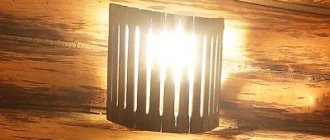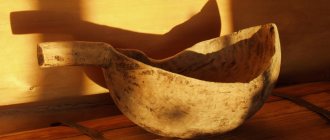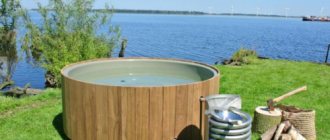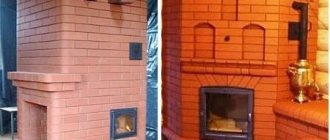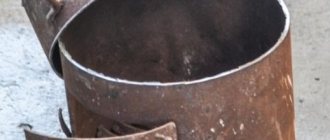Let's start with the fact that using a lampshade in a bathhouse automatically assumes that a point light source .
Because LED strip lights don't need anything like that. The following clarification concerns rooms in which lampshades can be used. So the main function of this part of the lamp is to slightly dim the light from the lamp; it is appropriate to use them in any of them, especially since the lampshade is also one of the varieties (however, now we use this word not only for round ceiling shapes, but many glass products scatter light).
Since the choice of item is determined by such factors as the style of the interior, the taste of the owner and his financial capabilities, we will limit the topic of our article to the decorative elements of the lamps that are used in the steam room - there are a number of restrictions associated with them that you should know.
Design features of a salt brick bath
Salt bricks for baths, as well as slabs, can withstand heating up to 550 degrees.
They purify the air and give it the properties of sea air. Due to this, salt procedures in such steam rooms have a beneficial effect on the human body. Salt blocks are used to finish the floors, walls and ceiling of a Finnish sauna. The material has a natural relief and beautiful pattern. Therefore, it looks very beautiful.
Since salt slabs and blocks, as well as their installation, are expensive, walls are often decorated with such materials. If you build lighting behind them or under them with strips of LEDs, you can softly illuminate the blocks.
Choosing glue for laying blocks
When installing salt blocks and slabs in the sauna, it is recommended to choose the correct adhesive.
- To glue all materials together, glue with caustic magnesite is purchased. It should be diluted with water according to the instructions.
- Experienced craftsmen advise preparing a special adhesive mixture of magnesite and magnesium chloride. The proportion of components is 3:5. First add salt to warm water. After its dissolution, magnesite is added. The resulting mixture is applied to the blocks in a five-centimeter layer. Since the mixture is not a very beautiful color, it should be used carefully. To decorate the seams, if necessary, you can use multi-colored tile adhesive.
- Sometimes the blocks are fastened together with silicate glue (liquid glass). This product is less durable, but looks more attractive.
Salt blocks are attached with special glue
Himalayan salt blocks are best attached to special glue, which is completely harmless. It does not emit odor and perfectly holds not only salt blocks, but also concrete, wooden beams, plywood, plaster, and brick. Additives are added to the adhesive mixture that protect the salt surface from the influence of harmful microbes. The glue dries very quickly. Resistant to moisture, high or low temperature.
Installation features
Before working with salt blocks, the area where they will be attached must be cleared of debris and other material. If you plan to mount the salt block to a wooden surface, it is recommended to pre-treat it with coarse sandpaper.
If the blocks will be attached to a glass surface, you should go over it with light-grain sandpaper. After which the glass must be degreased.
Often salt slabs are attached to stainless or other metal frames. For installation to be successful, it is necessary to create a large area of contact between the glue and the metal.
Before applying the adhesive, it should be mixed well.
Salt blocks also need to be degreased and cleaned from dust and dirt with a brush.
The glue is applied with a notched spatula to the surface of the block and to the wall several centimeters thick. Then the block must be attached to its permanent location.
When laying the first row, it is also necessary to apply glue to the floor.
It is recommended to carry out installation work in dry and warm weather. Make sure that there is no draft in the room during the day.
The bathhouse is lined with Himalayan salt to create a beautiful panel, as well as disinfect the air. Salt in the bathhouse has a beneficial effect on the human body, helping it get rid of various diseases. It is better to entrust the installation of salt decor to a specialist, but the salt procedure itself is recommended to be carried out only after visiting a doctor.
The main mistakes when installing salt and recommendations from experts are in the next video.
https://youtube.com/watch?v=PsTFX2KcL5A
Selecting a light source
Fiber Optic Spot Lighting
The most suitable option, in our opinion.
It does not require replacement of lamps (the service life of the LED in the projector is 50,000 hours).
The fiber can withstand temperatures up to 180 °C.
You can vary the brightness of the lighting by the number of points used per meter.
There is only one drawback - the relatively high cost.
Linear fiber optic lighting
The most expensive option.
Due to the design features, it will not be possible to install it everywhere, because... The fiber length of all rulers is the same, and the rulers themselves are installed at different distances from the projector.
Withstands lower temperatures than dots (80 °C).
LED tubes
We are talking about tubes from manufacturers of sauna equipment.
They have a protective box, which makes it possible to operate them at high temperatures.
After the tube burns out, it needs to be replaced.
The tubes have a set of fixed lengths.
LED strips
Such tapes are produced, among other things, by manufacturers of equipment for the construction of saunas. They have a protective shell, thanks to which they can be used at high temperatures.
After burnout, they require replacement.
Despite the protective sheath, such tapes are still not designed to withstand the same high temperatures as optical fiber.
Safety precautions and operating rules for homemade lighting devices
When making a homemade lamp, you must follow the safety rules:
Lamps must be protected with special shades
They are made of glass, which can be transparent or frosted. It is important to insulate the wires with special plugs. You need to choose materials that are resistant to frequent temperature changes and moisture. After assembling a homemade lamp, you need to check its functionality
After assembling a homemade lamp, you need to check its functionality.
Lamps in the bathhouse create a certain level of comfort. Therefore, you need to take the issue of choosing lighting with great responsibility.
Drying wooden lampshades: mistake or highlight?
Once the lamps have taken their shape, you can set them out to dry before adding the finishing touches.
The author decided to speed up the process and put the blanks to dry by the stove. As a result, they cracked. Not deep enough to fall apart, but quite noticeable
Is it worth being upset about such an incident? Decide for yourself, but the author was not at all upset. He defined his products as corresponding to a rustic style that advocates exceptional naturalness. And he is, in general, right. The presence of small defects will only emphasize the natural material. And if you use well-dried wood for your work, then it is possible that you will not have such a problem at all.
Can it harm
Like any type of this mineral, Himalayan salt is harmful only in excess quantities. Its evaporation does not have a negative impact - you can at least build a bathhouse entirely from salt bricks. But you should consume salt internally in moderation: it still contains sodium chloride, albeit in relatively small quantities (from 15% to 20%).
Contraindications for interaction with Himalayan salt:
- malignant tumors (however, for benign ones, you must ask your doctor’s permission before using the mineral);
- blood diseases;
- thrombophlembitis;
- pregnancy;
- renal failure.
If you have any of the above problems, you must refrain not only from using Himalayan salt, but also from bath procedures in general. Its use should also be avoided if you have an intolerance or hypersensitivity to sodium chloride.
You should be wary of low-quality fakes. Often, under the guise of real salt from the Himalayas, they sell rock or sea salt, tinted pink. Such a counterfeit can harm the body due to dye fumes.
Lamp
As a rule, lamps made from pieces of salt are factory-made, and bathhouse owners most often go to the store to buy a ready-made product, although you can make it yourself.
The easiest way to use Himalayan salt in a bathhouse is to secure a wooden basket in a pre-selected place in the bathhouse, into which salt is poured in the form of small pieces or coarsely ground pebbles. An ordinary light bulb (preferably LED) of a warm color is attached to the inside of the basket for illumination. This option is the most budget-friendly option for a lamp made from Himalayan pink salt.
A somewhat more complex and expensive, but also more advantageous way to use salt tiles for a bath is to create a full-fledged portable lamp from Himalayan salt tiles. To do this, the tiles are laid in a special way - in the form of a box without a bottom. Individual tiles can be secured to each other either using special glue or with clamps made of metal or any other durable material.
The assembled lamp must be mounted on a base made of wood or plastic, made in the form of a regular plate (for example, a sheet of plywood). The socket with the lamp is also brought from below and fixed to the base so that the lamp itself does not touch the walls of the lamp.
Types of illuminated walls
Installation of brick panels using Himalayan salt adhesive
This installation method, in our opinion, is the most preferable: we get a monolithic structure that will hold securely and will not require further maintenance.
With this installation method, it would, of course, be appropriate to use a fiber optic kit with the projector. If you choose an LED strip or tube, you will need to organize access behind the wall (if possible), or accept the fact that when the strip (tube) burns out, the wall will no longer be illuminated.
You can purchase adhesive composition for salt products from anyone who sells Himalayan salt. It is usually mixed with water in a certain proportion, and does not set immediately. After this composition has completely hardened, your wall becomes monolithic. It is important to note that when using bricks, you most likely will not need to prop up the wall while it dries, since the salt brick will be held up due to its width. To fix it in a horizontal plane in the room being used, it is necessary to use support strips from the inside and layouts from the outside.
The finished version looks like this:
Installation of tile panels using Himalayan salt adhesive
Unlike brick, tiles will most likely not hold up when the mortar dries, so the structure must be supplemented with temporary support. You will also need constant support, because even after the mortar has completely set, a tile wall will not be as stable as a brick wall. As a permanent support, you can use a large metal mesh on which the panel will rest.
It is also necessary to provide for attaching the salt panel to the mesh, because we do not have any support in front. In the photo, the salt tile is tied with a nylon thread threaded through a mesh, i.e. we actually tie our panel to a grid, as a result of which it is fixed in space.
Recommendations for the light source are the same as in the first paragraph.
The result will look like this:
"Dry" installation
In our opinion, the least justified type of installation is associated with a number of inconveniences and further maintenance.
I’ll say right away that due to the complexity of maintenance and the unsuitable quality of the source material, we currently do not use this type of installation.
About application
For a sauna or bath, Himalayan salt can be used in several ways. Let's start with the most cardinal and interesting:
Method No. 1: cladding
Completely laying out walls from such material is not a cheap task, although it is also sometimes practiced by reputable public institutions. But the finishing is quite affordable even for a private owner.
For clarity, let's look at the prices of building materials made from Himalayan salt:
| Photo | Name, sizes and price |
| |
|
As you can see, the difference in cost is obvious.
The tiles are installed using a special adhesive, which has a number of important properties:
- Non-toxic and odorless. These are very important qualities for a health resort;
- The composition contains antiseptic additives, which allows you to better tolerate the humid climate of a Russian bath;
- Excellent adhesion to almost all possible surfaces: wood, concrete, plywood, plaster and brick;
- Hardens quickly;
- Tolerates both high and low temperatures;
- Easy to apply with your own hands.
Essentially, the instructions for applying Himalayan salt tiles are the same as for ceramic tiles or tiles
In addition to the healing effect, it is also worth noting the aesthetic one, because as a result you will have a beautiful pink steam room, the unusualness and mystery of which will be appreciated by all guests.
The steam room, the walls of which are lined with Himalayan salt tiles, looks fantastic
It is noteworthy that the temperature resistance of the material in question makes it possible to decorate even a stove with it. This option will ensure a more intense release of salt vapor into the air.
A heater surrounded by tiles or bricks made from Himalayan salt quickly fills the steam room with healing vapors
Method No. 2: lighting fixtures
This is a slightly more exotic method that can be used not only for the steam room, but also for the relaxation room. Lamps made from Himalayan salt will perfectly fit into any interior, becoming its main decoration, and the warmth of the light bulb will ensure the release of healing vapors into the surrounding air.
A lighting fixture with a salt lamp can be an excellent addition even to the interior of the living room.
Devices such as ordinary lamps are installed, and you can also buy them in the same way. Here are examples of some models:
Model "Cob":
| Parameter | Description |
| Weight | 2000-4000 g |
| Price | 1600 rubles |
The “Lump” model, in accordance with its name, looks more like a broken piece of rock than a lighting fixture
Model "Scala" worth 600 rubles;
The Scala model can be connected to the USB port of your computer
Useful properties of the mineral
Himalayan salt is a complex healing mineral. It is recommended not only by practitioners of alternative medicine, but also by doctors with good education and extensive experience. Salt has the following beneficial properties:
- supplies the body with important microelements (for example, iron, the lack of which is felt by many city residents);
- Helps cleanse the body and remove toxins;
- accelerates the restoration of damaged cells;
- calms the nerves;
- tones all the muscles of the body;
- kills harmful bacteria;
- externally rejuvenates the body;
- increases blood flow to the extremities (useful for people whose hands and feet are always cold).
Medical recommendations for the use of salt from the Himalayas boil down to the enormous benefits of its evaporation. The mineral evaporates when heated - both during cooking and during bath procedures. Salt vapors can treat a number of diseases:
- diseases of the digestive system;
- ailments of the genitourinary system;
- asthma;
- problems with the musculoskeletal system;
- vascular and heart diseases;
- hypertension;
- psoriasis, dermatitis and other skin problems;
- allergic reactions;
- irritation and inflammation of the gums;
- chronic fatigue.
You can also rinse your mouth with a salt solution to achieve fresh breath. And compresses or baths with saline solution relieve swelling on the legs and remove blue bags under the eyes.
Material
In principle, the material can be stainless metal or glass, but we are talking about a bathhouse, or rather, even a steam room, so metal can be immediately rejected, because it will heat up and can burn. Glass…
Glass
Using glass in a steam room and washing room is quite acceptable if we are talking about a matte lampshade that hermetically protects the light bulb inside from water. Actually, there is not much choice here - you need a translucent material that transmits light well. Plastic is not suitable for a steam room (we note in parentheses that it is not suitable even if it is produced by Harvia).
Decorative parts are made from other materials, which are discussed below.
Wooden
In this case, wood should be considered the optimal material, given that the vast majority of owners choose it as a finishing material. So, in a log house or in a clapboard-lined steam room, a wooden structure will look best.
Wood differs depending on the type of wood. Of course, there is not always a choice, but listen to our words:
Any deciduous tree will do. Only if you are going to do something delicate, then softer species, such as linden or aspen, are suitable, and any tree is suitable for a more simple design.
With Himalayan salt
Himalayan salt in this case is used as a light-diffusing screen. This is possible both when choosing plates from it, and when filling the container with lump material.
Rock salt, of course, is harder than table salt, but its composition is approximately the same (with the exception of various additives such as iron, which gives it a reddish tint, and other salts - for example, sulfates, borates). What this means, first of all, is that under the influence of moisture and heat, halite (the name of the mineral is the same as “rock salt”) will slowly but steadily dissolve.
Regarding the fact that the effect of salt is healing... Well, NaCl (sodium chlorine) there is exactly the same as in a salt shaker. Other supplements are somehow not necessarily useful, like vitamins. Why do you need sulfur or boron salts? Microelements - if they are really released as actively as they say - will not interfere, we will not argue.
Salt plates or irregularly shaped pieces are very beautiful, especially when light filters through them. So the main argument in favor of choosing such a lampshade, after all, will be beauty.
Bath lampshade: shape
An interesting point: somehow it happened historically that there are two main forms - a grille and a screen. We will assume that other options, if they existed, died out due to some kind of unsuitability or inconsistency. Or the survivors turned out to be the simplest and most practical. (Of course, no one forbids doing something original; we are talking about the most common.)
Lattice
The question arises: what else could be made from slats or solid planks? The simplest and most effective way is to assemble a lattice, a kind of “fence,” leaving slits for light.
IMPORTANT! The brightness of the lighting depends on the width and number of slots.
However, even with the simplicity of the idea, variations can be sufficient - the slats can be attached to bases that will give the structure a cylindrical or conical shape, or they will be combinations of simple shapes, if you like.
BY THE WAY! The slats may not be solid - if you make a slotted pattern in them, then there will be a combination of a lattice and a screen.
The attractiveness of this form is that it harmonizes perfectly with walls finished with clapboard, or with log walls or timber. Overall, a lattice wood lampshade looks great on a wood wall. And the material for it can also be the remains of the same lining, unused during construction.
Screen
It differs from the previous version in the absence of slots between the slats . And also because some recognizable outline is usually carved into the central element. However, here, too, various variations are possible - there can be as many slotted elements as you like, not necessarily one central one.
Combinations are possible , when a lattice is made on the sides, and in the center there is a solid strip with a cut out outline.
The slot can be left as is, without any inserts, or you can experiment - put a decorative or practical diffusing material on the back side, for example, mesh or frosted glass (we’re not talking about plastic, because it’s hot in the steam room). Without the matte material, the light may be too harsh.
ADVICE! Instead of matte material, you can use a plate with numerous small holes.
Correct lighting for the washing area
In a small wash room, 1 lamp will be enough. The lampshade must be sealed to prevent water splashing on the lamp and/or socket.
Wiring for lighting fixtures in the bathhouse must be insulated especially carefully. This will prevent accidental contact of moisture and electricity.
Lighting in the washing room should also be moisture-proof
A large wash room requires the installation of several lamps. Therefore, when choosing their location, you need to take into account the location of the bathtub, sink, bidet, shower stall. It is better to do preliminary zoning of the premises.
As a rule, the washing room is divided into 3 zones:
- in close proximity to a source of moisture;
- at a distance of 0.6 m;
- in a relatively dry space.
Moisture levels are highest near a water source. Therefore, in this area you can install 12 volt bath lamps and lamps. IP indicator for protection against moisture is at least 45 units.
A zone located approximately 60 cm from a direct source of moisture is considered remote from moisture. Here you can use lamps and lamps with an average level of protection.
LED lighting can even be used in a swimming pool
In a dry area, located away from faucets, shower heads, swimming pools, etc., you can use lighting fixtures and lamps with the lowest level of protection.
How to choose?
The lamp cap must be selected after the renovation, when all the furnishings have already taken their place. The fact is that a pre-purchased floor lamp may simply not fit into the finished interior, and using the wrong model will negate all design efforts.
If you are faced with the problem of choosing a cap for furniture, pay attention to the bright upholstered furniture in your room. As a rule, a plain lampshade of the same shade will fit perfectly
For a child's room, you should opt for bright samples with drawings, for example, with characters from the child's favorite cartoon. You can glue applications with different animals, stars, cars onto the lampshade.
For the bedroom, it is best to choose neutral models that do not distract from sleep. The optimal choice is non-contrasting lampshades. For example, in a lemon-gray room, both gray lampshades and light lemon-colored products will look good
It is important to rest your eyes when looking at the lampshade
Positive effects of salt procedures and contraindications
Staying in a bathhouse saturated with salt compounds has a number of positive effects. Air saturated with microelements:
- normalizes the functions of the nervous system, relieves tension, relaxes;
- disinfects, heals small cracks and wounds on the skin, restores the structure, providing increased elasticity and firmness;
- activates sweating, which ensures the removal of waste and toxins;
- stimulates blood flow, creating improved nutrition and oxygen supply to cells;
- has an analgesic effect for joint diseases;
- destroys fungal microorganisms;
- eliminates foci of inflammation in the respiratory system.
Requirements
The lamp as a whole should not be afraid of moisture. Since you are conducting electricity into a damp room, you should take utmost care to ensure that it does not come into contact with water. And for greater safety, you should connect an RCD (if you have questions about the theory of bathhouse electrics or its practical application in a bathhouse, follow the links, we have detailed materials on these topics).
So, tightness comes first. And for a steam room, heat resistance is also important - the lamp should not be destroyed by high temperature.
Well, it’s also environmentally friendly - it’s impossible for any harmful organic matter to evaporate from it under the influence of temperature.
And fire safety - it should not support combustion.
You will learn about which lamps can be installed in a bathhouse and which ones can be installed in a sauna by following the links. A separate material combines information about the light in the steam room.
We also have material entirely dedicated to LED light sources.
In principle, the material can be stainless metal or glass, but we are talking about a bathhouse, or rather, even a steam room, so metal can be immediately rejected, because it will heat up and can burn. Glass…
Using glass in a steam room and washing room is quite acceptable if we are talking about a matte lampshade that hermetically protects the light bulb inside from water. Actually, there is not much choice here - you need a translucent material that transmits light well. Plastic is not suitable for a steam room (we note in parentheses that it is not suitable even if it is produced by Harvia).
Decorative parts are made from other materials, which are discussed below.
Wooden
In this case, wood should be considered the optimal material, given that the vast majority of owners choose it as a finishing material. So, in a log house or in a clapboard-lined steam room, a wooden structure will look best.
Wood differs depending on the type of wood. Of course, there is not always a choice, but listen to our words:
Any deciduous tree will do. Only if you are going to do something delicate, then softer species, such as linden or aspen, are suitable, and any tree is suitable for a more simple design.
With Himalayan salt
Himalayan salt in this case is used as a light-diffusing screen. This is possible both when choosing plates from it, and when filling the container with lump material.
Rock salt, of course, is harder than table salt, but its composition is approximately the same (with the exception of various additives such as iron, which gives it a reddish tint, and other salts - for example, sulfates, borates). What this means, first of all, is that under the influence of moisture and heat, halite (the name of the mineral is the same as “rock salt”) will slowly but steadily dissolve.
Regarding the fact that the effect of salt is healing... Well, NaCl (sodium chlorine) there is exactly the same as in a salt shaker. Other supplements are somehow not necessarily useful, like vitamins. Why do you need sulfur or boron salts? Microelements - if they are really released as actively as they say - will not interfere, we will not argue.
Salt plates or irregularly shaped pieces are very beautiful, especially when light filters through them. So the main argument in favor of choosing such a lampshade, after all, will be beauty.
Sauna lampshade: design
Regardless of the chosen material and shape of the future lamp, there are two standard types of design that are designed to be placed either along the wall or in one of the corners.
Corner
This design is considered more compact, as it occupies space that is usually empty during soaring procedures. Therefore, there are fewer options for awkwardly touching or breaking, and the light spreads along two walls at the same time.
In the “top view” projection, it is either a triangle or a trapezoid. This allows it to be mounted on both walls, providing greater stability.
Wall-mounted
The corner location is not always optimal. Then you can use the option of placing the lampshade on the wall surface.
ADVICE! If possible, step back some distance from the ceiling; in a steam room, it is not advisable to mount lamps on the ceiling or directly below it, because the hottest air and steam collects near the ceiling.
Wall-mounted options can be quite varied in design, but when placing it, it is worth considering the convenience of steamers and the direction of light on the objects used in the steam room.
Load-bearing base from scratch
To make a supporting frame for the lampshade, it is recommended to use copper metal wire. It bends easily and does not heat up as much as its aluminum counterpart.
On the other hand, the remote location of the lampshade from the lamp allows you to use even aluminum wire. The main thing is that its cross-section is at least 5 mm. Otherwise the wire will break.
It’s easy to get wire from copper or aluminum - just cut the cable from old electrical equipment and extract the thematic material from it. If its cross-section is small, then you can weave two or three wires into one. But the solution to the problem of how to make a lampshade with your own hands depends on its shape. The latter happens:
- Conical;
- A-line (skirt);
- Cylindrical;
- Oval.
Obviously, the thematic frame welcomes the upper and lower trims (under the lamp and the bottom of the lampshade) - rings of the same or different diameters. The straps are attached to each other using wire rods.
Actually, the length and shape of the twigs give the frame the desired appearance. But the number and cross-section of vertical elements affect the reliability of the supporting base.
Basic principles
In order to make a backlit panel in the steam room, you need to leave a gap of 3-6 cm between the bricks (tiles) and the wall in which the light sources will be located. This gap is necessary, firstly, in order to somehow position the light sources behind the salt, and secondly, so that there is the necessary space for the spread of reflected light. Why exactly reflected? The fact is that if you simply place a powerful light source, it will shine brightly only in one place, that is, it will be point-like. We need to create as uniform illumination as possible. This is achieved only through reflection and re-reflection. The light will be reflected from the foil or film located behind the light sources; be reflected - from the inner surface of the salt itself. How brightly the panel will glow depends on:
- power of light sources;
- the effectiveness of their reflection;
- the thickness of the panel itself.
Everything is clear with the first two points, but what about the thickness? Depending on whether you choose tile or brick, your design will be different.
You can choose a lighting option based on the criterion of replacing light sources: either the element itself is located directly behind the salt, or it is located in another place. Sources that are behind the salt - LED strips (tubes), incandescent lamps; outside the panel there is a projector with an LED that illuminates the panel through an optical fiber. Accordingly, to replace the LED strip, you will need access to its installation site. There are two access options: behind the wall or in front, i.e. dismantling the wall. In the case of fiber optics, the projector must be replaced, which may be located outside the steam room, or under shelves (with a service life of 50,000 hours, this is unlikely to be necessary).
How to make a lamp for a bathhouse with your own hands
Making a lighting system for a sauna steam room is a fairly creative process, so there are no strict schemes or restrictions by which the design, shape and general structure of the lamp is selected. But do not forget that the lighting system is planned for a room in which the air temperature and humidity can reach 80o and 90%, respectively. Therefore, before you start making a lamp for the steam room with your own hands, let’s clarify some design requirements:
- The best material for making the frame and lampshade is linden or aspen wood. Anything will do, you can use vines, profiled planks, trimmings of slats and lining, and even tree branches;
- You cannot make a bath lamp from plastic or paint wood with non-heat-resistant varnishes and paints;
- The light bulb socket should only be ceramic, no ebonite or heat-resistant plastic;
- It is best to provide a protective shade in the design of a bath lamp;
- The external lampshade covering the light source can be of any shape and size, but it must be attached to the wall of the steam room using screws and nails, or any other mechanical fastener, no glue or wooden pins.
Advice! If the design uses a regular incandescent lamp, then it is recommended to glue a ring made of heat-resistant silicone onto the upper edge of the socket, which will seal the gap between the glass bulb and the ceramic.
A primitive modification of the standard cartridge allows you to avoid the ingress of microdroplets of water during the process of washing and cleaning the steam room and the entire sauna room.
As a basis for the lighting system in the steam room, it is better to take the popular “Linder”, which is resistant to moisture and high temperature.
Required Tools
The more complex the design of the lampshade and the entire lamp, the more tools and devices will be required for its manufacture. A simple, but at the same time quite nice and convenient version of a wooden sconce for the wall of a steam room can be made using a simple set of tools:
- A set of drawing patterns, rulers, copiers, - any marking devices that help transfer the contours from the drawing to wooden boards and planks;
- Electric drill, hand or machine;
- Electric sharpener with roughing and polishing wheel;
- Hand hacksaw for wood with fine teeth;
- A set of sandpaper with different grain sizes;
- Hammer and wallpaper nails.
In some cases, it is necessary to make additional devices and fixing frames on which the body of the lampshade and the supporting frame can be assembled and knocked down. Therefore, when planning to make a lamp for a steam room with your own hands, you need to at least think through the stages of its assembly and, if possible, prepare in advance the necessary equipment, at least a clamp, tape and steel or copper wire.
The Harvia lamp is used for baths and steam rooms, the best option for basket-type lampshades
Materials for making lamps
It is clear that the main material from which lighting systems for baths are made has been and remains the wood of the species that are most resistant to moisture and high temperatures. With the possible exception of red cedar, sandalwood, and ash, the texture and grain pattern of other types of wood is not particularly expressive or beautiful. Even aspen or linden do not look very interesting.
The exception is the texture of larch, but using coniferous lining to make a bathhouse lamp with your own hands from wood is only possible for auxiliary rooms, for example, a dressing room or a rest room. It is better not to use larch in the steam room, or, before trying to make a body of the workpiece, you need to bleach and remove the resin with a mixture of alcohol and acetone, then with an aqueous solution of ammonia.
A universal lampshade option for any bath room
Advice! If someone likes the tart, rich smell of pine needles, then it is best to try to make a body from juniper branches.
Recently, the use of Tibetan or Altai salt has become extremely popular. Inserts made of salt plates and blocks are used as a scattering screen, and at the same time a device for disinfecting and improving the atmosphere in the bathhouse.
How to use Himalayan salt in a bath
There are several different ways to use Himalayan bath salt as decoration, taking advantage of the unusual appearance of this mineral:
Buy a salt lamp. This is, in fact, a rather original lamp, which is a piece of salt with a light bulb placed inside. If you plug such a lamp into the network, it will shine with a pleasant reddish-yellow light. An excellent solution for baths and saunas, and you can choose a lamp based on the size of the room: the larger the area, the more massive the piece of mineral will be.
- Buy a small amount of salt by weight and put it in a beautiful decorative bowl, then hang it in the bathhouse. In this form, it will be a wonderful addition to the interior.
- Lay out a partition wall from salt blocks between the bathhouse itself and the dressing room. They are fastened together with special glue or attached to a metal frame.
- You can not limit yourself to just one partition, but cover one or more walls and floor with slabs, lay out intricate paths on it, and decorate the ceiling with salt tiles.
- The most expensive option is to lay the entire wall out of pink bricks and backlight it with lamps. Thus, it is possible to achieve a unique atmosphere, creating an atmosphere of relaxation and tranquility. It turns out that going to the bathhouse cleanses not only the body, but also the thoughts and soul, anxiety is reduced, and depression is alleviated.
For baths and saunas - is there a difference?
The difference between one and the other type of national bath is the temperature and amount of moisture . In a Russian bath there is high humidity and a relatively low temperature (no higher than 70 degrees), and in a sauna the humidity is low (5-15%), but the temperature is not less than 90 degrees, and sometimes even higher than 100!
Therefore, those varieties that are more sensitive to high humidity should not be placed in a Russian bath. This primarily applies to the Himalayan salt lampshade for the bath. As mentioned above, it consists of the usual soluble salt NaCl, so moisture will ruin it.
protected from moisture using impregnations and varnishes, which you can read about in the corresponding article.
High temperatures are contraindicated for most types of plastic, so it is strictly forbidden , but moderately in Russian baths, and this does not apply to lamps, because there the heating comes from the lamps themselves.
Otherwise, there is not much difference - the same wooden models can be used as lampshades for baths and saunas.
